The process of making an organic compost from manures:
Composting plays a major role in agriculture, farming and gardening. One should have proper knowledge on how to make organic compost from wastes and manure. We present a step by step guide of making compost on your own.
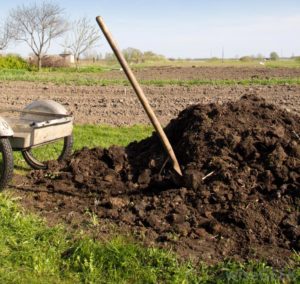
Introduction:
This article details about making your own organic compost from manures. Any gardener or farmer will benefit from adding nutrients and organic matter to the soil in order to grow plants well. One of the most popular and beneficial things to add is compost. Compost can be purchased at any garden supply center, but it is very easy and less expensive to make your own compost.
Manure inputs for Compost:
Manures are plant and animal wastes that are used as sources of plant nutrients. They release nutrients after their decomposition. The art of collecting and using wastes from animal, human and vegetable sources for improving crop productivity is as old as agriculture. Manures are the organic materials derived from animal, human and plant residues which contain plant nutrients in complex organic forms. Naturally occurring or synthetic chemicals containing plant nutrients are called fertilizers. Manures with low nutrient, content per unit quantity have a longer residual effect besides improving soil physical properties compared to chemical fertilizer with high nutrient content. Major Input sources of manures are:
-
Cattle shed wastes-dung, urine, and slurry from biogas plants
-
Human habitation wastes-night soil, human urine, town refuse, sewage, sludge, and sullage
-
Poultry Jitter, droppings of sheep and goat
-
Slaughterhouse wastes-bone meal, meat meal, blood meal, horn and hoof meal, Fish wastes
-
Byproducts of agro industries-oil cakes, bagasse and press mud, fruit and vegetable processing wastes, etc
-
Crop wastes-sugarcane trash, stubbles, and other related material
-
Water hyacinth, weeds, and tank silt, and
-
Green manure crops and green leaf manuring material
Manures can also be grouped, into bulky organic manures and concentrated organic manures based on the concentration of the nutrient
Bulky organic manures:
Bulky organic manures contain a small percentage of nutrients and they are applied in large quantities. Farmyard manure (FYM), compost and green-manure are the most important and widely used bulky organic manures. Use of bulky organic manures has several advantages:
- They supply plant nutrients including micronutrients
- They improve soil physical properties like structure, water holding capacity, etc.,
- They increase the availability of nutrients
- Carbon dioxide released during decomposition acts as a CO2 fertilizer and
- Plant parasitic nematodes and fungi are controlled to some extent by altering the balance of microorganisms in the soil.
Farmyard manure (FMY):
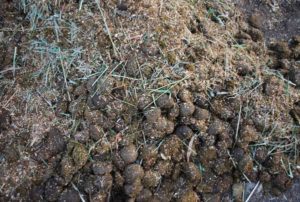
- Farmyard manure refers to the decomposed mixture of dung and urine of farm animals along with litter and leftover material from roughages or fodder fed to the cattle. On average well-decomposed farmyard manure contains 0.5 percent N, 0.2 percent P2O5and .0.5 percent K2O. The present method of preparing farmyard manure by the farmers is defective. Urine, which is wasted, contains one percent nitrogen and 1.35 percent potassium. Nitrogen present in urine is mostly in the form of urea which is subjected to volatilization losses. Even during storage, nutrients are lost due to leaching and volatilization. However, it is practically impossible to avoid losses altogether, but can be reduced by following the improved method of preparation of farmyard manure. Trenches of size 6 m to 7.5 m length, 1.5 m to 2.0 m width and 1.0 m deep are dug.
- All available litter and refuse is mixed with soil and spread in the shed so as to absorb urine. The next morning, urine soaked refuse along with dung is collected and placed in the trench. A section of the trench from one end should be taken up for filling with the daily collection. When the section is filled up to a height of 45 cm to 60 cm above the ground level, the top of the heap is made into a dome and plastered with cow dung earth slurry. The process is continued and when the first trench is completely filled, the second trench is prepared.
- The manure becomes ready for use in about four to five months after plastering. If urine is not collected in the bedding, it can be collected along with washings of the cattle shed in a cemented pit from which it is later added to the farmyard manure pit. Chemical preservatives can also be used to reduce losses and enrich farmyard manure. The commonly used chemicals are gypsum and superphosphate. Gypsum is spread in the cattle shed which absorbs urine and prevents volatilization loss of urea present in the urine and also adds calcium and sulfur. Superphosphate also acts similarly in reducing losses and also increases phosphorus content.
- Partially rotten farmyard manure has to be applied three to four weeks before sowing while well-rotted manure can be applied immediately before sowing. Generally, 10 to 20 t/ha is applied, but more than 20 t/ha is applied to fodder grasses and vegetables. In such cases, farmyard manure should be applied at least 15 days in advance to avoid immobilization of nitrogen. The existing practice of leaving manure in small heaps scattered in the field for a very long period leads to loss of nutrients. These losses can be reduced by spreading the manure and incorporating by plowing immediately after application.
- Vegetable crops like potato, tomato, sweet potato, carrot, radish, onion, etc., respond well to the farmyard manure. The other responsive crops are sugarcane, rice, Napier grass and orchard crops like oranges, banana, mango and plantation crop like coconut.
- The entire amount of nutrients present in farmyard manure is not available immediately. About 30 percent of nitrogen, 60 to 70 percent of phosphorus and 70 percent of potassium are available to the first crop.
You may be interested in Green Leaf Manure Advantages, Making.
Manures from Sheep and Goat
The droppings of sheep and goats contain higher nutrients than farmyard manure and compost. On average, the manure contains 3 percent N, 1 percent P2O5 and 2 percent K2O. It is applied to the field in two ways. The sweeping of sheep or goat sheds are placed in pits for decomposition and it is applied later to the field. The nutrients present in the urine are wasted in this method. The second method is sheep penning, wherein sheep and goats are kept overnight in the field and urine and fecal matter added to the soil is incorporated to a shallow depth by working blade harrow or cultivator or cultivator.
Manures from Poultry:
The excreta of birds ferment very quickly. If left exposed, 50 percent of its nitrogen is lost within 30 days. Poultry manure contains higher nitrogen and phosphorus compared to other bulky organic manures. The average nutrient content is 3.03 percent N; 2.63 percent P2O5 and 1.4 percent K2O.
Read: Poultry Farming Business Plan.
Concentrated organic manures:
Concentrated organic manures have higher nutrient content than bulky organic manure. The important concentrated organic manures are oil cakes, blood meal, fish manure, etc. These are also known as organic nitrogen fertilizer. Before their organic nitrogen is used by the crops, it is converted through bacterial action into readily usable ammoniacal nitrogen and nitrate nitrogen. These organic fertilizers are, therefore, relatively slow acting, but they supply available nitrogen for a longer period.
Oil cakes Manures:
After the oil is extracted from oilseeds, the remaining solid portion is dried as the cake which can be used as manure. The oil cakes are of two types:
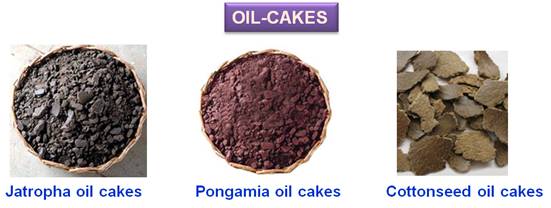
- Edible oil cakes which can be safely fed to livestock; e.g.: Groundnut cake, Coconut cake, etc., and
- Non-edible oil cakes which are not fit for feeding livestock; e.g.: Castor cake, Neem cake, Mahua cake, etc.,
Both edible and non-edible oil cakes can be used as manures. However, edible oil cakes are fed to cattle and non-edible oil cakes are used as manures especially for horticultural crops. Nutrients present in oil cakes, after mineralization, are made available to crops 7 to 10 days after application. Oil cakes need to be well powdered before application for even distribution and quicker decomposition.
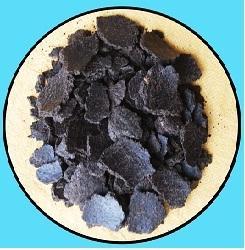
Now we will look into the making of Organic Compost from Manure Inputs:
Composting:
Composting is a technique or process used to accelerate the natural decay process. The technique converts organic wastes to a mulch which is used to fertilize and condition the soil. Leaf waste decomposes naturally in about two years. Composting can take as long as a year or as little as 14 days, depending upon the amount of human control.
What material can be used in composting:
Most yard wastes can be composted into compost, including leaves, grass clippings, plant stalks, vines, weeds, twigs, and branches. Compostable food wastes include fruit and vegetable scraps, coffee grounds, eggshells, and nutshells. Other compostable materials are hair clippings, feathers, straw, livestock manure, bonemeal, and blood meal.
in Composting process, materials should NOT be composted if they promote disease, cause odors, attract pests, or create other nuisances. These include meat, fish, poultry, dairy products, foods containing animal fats, human/pet feces, weeds with developed seed heads, and plants infected with or highly susceptible to diseases, such as roses and peonies.
in composting process, materials that should be composted only in limited amounts include wood ashes (a source of lime), sawdust (requires extra nitrogen), plants treated with herbicides or pesticides (the chemicals need time for thorough decomposition), and black and white newsprint (composts slowly, so it should comprise no more than 10% by weight of the total pile).
Requirements of Compost preparation:
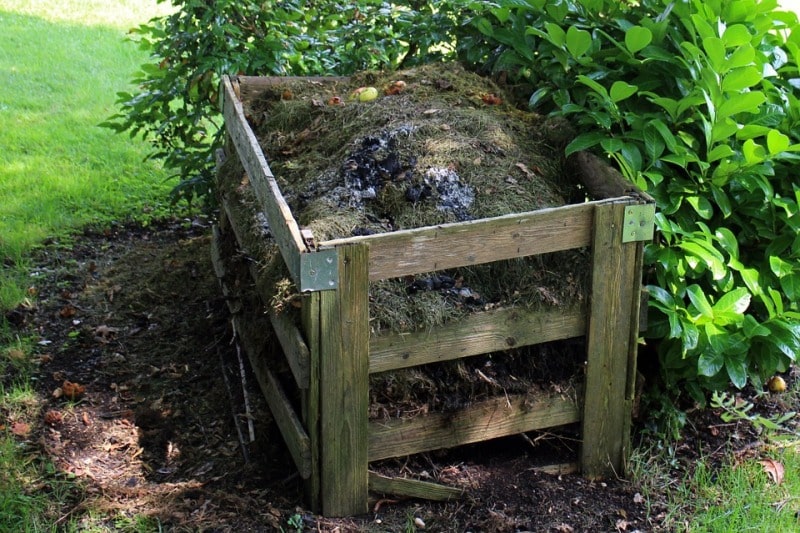
- Shredded Organic Wastes: Shredding, chopping or even bruising organic materials hastens decay. One way to shred leaves is to mow the lawn before raking, collecting the shredded leaves in the mower bag. It takes at least 34 cubic feet of shredded material to form compost pile.
- Good Location: The compost pile should be located in a warm area and protected from overexposure to wind and too much direct sunlight. While heat and air facilitate composting, overexposure dries the materials. The location should not offend neighbors.
- Nitrogen: Nitrogen accelerates the composting process. Good sources include fresh grass clippings, manure, the bloodmeal, and nitrogenous fertilizer. Lime should be used sparingly if at all. It enhances decomposition, but too much causes nitrogen loss, and it usually is not necessary unless the pile contains large amounts of pine and spruce needles or fruit wastes.
- Air: The organic compost pile and its enclosure should be well ventilated. Some decay will occur without oxygen, but the process is slow and causes odors.
- Water: Materials in the organic compost pile should be kept as moist as a squeezed sponge. Too little or too much water retards decomposition. Overwatering causes odors and loss of nutrients.
Enclosing the Compost:
Enclosing the compost pile saves space and prevents litter. The enclosure should be collapsible or provide an entry large enough to permit the pile to be turned. It should measure at least 4’X4’X4′ (a pile under 3 cubic feet generally does not decompose properly), but no taller than 6′ (too much weight causes compaction and loss of oxygen). The enclosure can be built of wood, pallets, hay bales, cinder blocks, stakes, and chicken wire, or snow fencing. Prefabricated compost bins are also available.
Read: Compost Questions and Answers.
How to build the Pile in the Compost:
Aside from the basic requirements for decomposition and preventing odors and other nuisances, there is no set method for building a compost pile. One technique may be faster than another, but a variety of methods work well. Piles can be built in layers to ensure the proper proportion of carbon (e.g., leaves, woody materials) to nitrogen (grass, fertilizer), but the layers should be thoroughly intermixed after the pile is built.
Maintaining the Compost:
Turning and mixing the pile with a pitchfork or shovel, or shifting it into another bin, provides the oxygen necessary for decomposition and compensates for excess moisture. A pile that is not mixed may take 34 times longer to decompose. Recommendations for mixing the pile vary from every 3 days to every 6 weeks. More frequent turning results in faster composting. Odors indicate that the pile is too damp or lacks oxygen and that more frequent turning is necessary.
Occasional watering may be necessary to keep the Organic compost pile damp, especially in dry weather. Covering the pile with black plastic reduces the need for watering; it also prevents rainwater from leaching out the nutrients.
A pile that is decomposing properly should generate temperatures of 140°-160°F at its center. The heat kills most weed seeds, insect eggs, and diseases. The pile should be turned when the center begins to cool. Turning the pile maintains the temperature and ensures that all material is exposed to the center heat. When the compost is finished, the pile will no longer heat up.
Small amounts of fresh materials may be added but should be buried inside the pile to avoid pests and speed composting. It is better to add fresh materials to a new pile.
Finished Compost:
Finished compost is dark brown, crumbly, and has an earthy odor. Depending upon seasonal temperatures, a well-built, well-tended pile generally yields finished compost in 2 weeks to 4 months. An unattended pile made with unshredded material may take longer than a year to decompose.
Read: How to Grow Chinese Cabbage at Home.
Hi
As I am running a poultry layer farm. I have to think about its waste. Therefore, I am looking to get a training on manure composting.
Please advise me.
Thanks & Regards
Shantanu
We are going to update with Organic Composting Project Report. Please wait for this update.
I would like to get training on Vermicompost Manufacturing in Trichy. Please advise the contact.